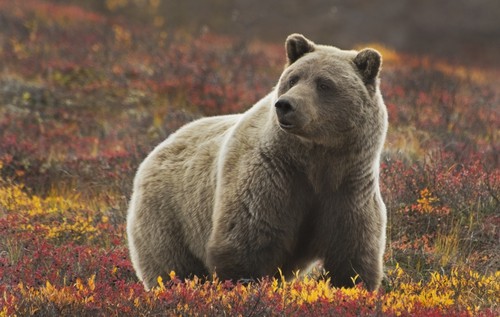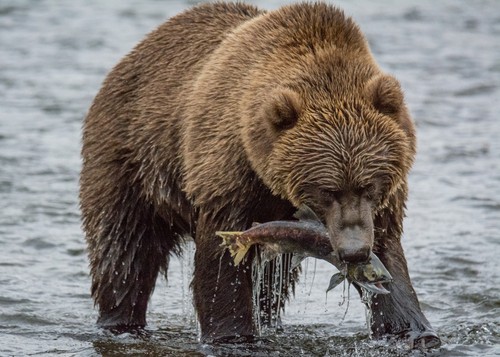There isn’t a scientific consensus on the number of extant Brown Bear sub-species. In the past, there were as many as 90 recognized brown Bear sub-species around the world. However, with the advent of genetic testing, scientists have narrowed down Brown Bear taxonomy to 5 clades worldwide. Source
At this point in time, Brown Bears are still categorized by sub-species. There 6 extant subspecies of North American Brown Bear. Scientists have determined that much of the phenotypical difference between these animals have much to do with geographic location and the nutrients they have access to. The six non-extinct North American Brown bear groups that are or have been recognized as distinct subspecies are the following; Grizzly, Peninsula Brown bear, Sitka, Dall Island, Stickeen, and Kodiak Brown Bear.

Grizzly bear
Grizzly bears are actually brown bears. They’re called inland or interior Grizzles to differentiate them from larger coastal Brown bears. The Grizzly name is interchangeable with all brown bears, but when we talk about grizzlies, we are most often talking about bears in the interior.
Grizzly bear Characteristics (Ursus arctos horribilis)
They have light tan to dark brown hair that is sometimes mixed with silver guard hairs to give them a grizzled look. Their faces are dished. They also have short with round ears and a prominent shoulder hump. The large hump is all muscle and gives the Grizzly extra power for digging and rolling boulders to hunt for whatever food is underneath. Their claws are extra-long, with the ones on the front feet going 4 to 6 inches.
Most adult Male grizzlies weigh from 400 to 790 pounds (180 to 360 kg), while female grizzlies weigh 290 to 400 pounds (130 to180 kg). On Average interior grizzlies are 6.5 feet long and 3.35 feet tall at the shoulder. They can swim effectively and are fast runners with a top speed of 35 miles per hour or (55kph)
Where do interior grizzly bears live?
Exact population figures for Alaska and British Columbia interior grizzlies are hard to come by since all official counts combine coastal and interior grizzlies in one lump sum. However, interior grizzly bears in Canada live in British Columbia, the Northwest Territories, the Yukon, Nunavut, Alberta, Saskatchewan, and Manitoba. Source In the United States, interior grizzlies live first and foremost in Alaska. In the lower 48 states, Washington, Montana, Idaho, and Wyoming all have grizzly bears.
Alaska Peninsula Brown bear (Ursus arctos gyas)
These are large bears. An average adult will measure around 8 feet long and be around 4 1/2 feet tall at the shoulder. The biggest ones measure up to 10 feet in length and 5 feet at the shoulder and weigh up to 1500 pounds. Brown bears are generally massive with small round eyes and ears and a dished-in snout. Their shoulders have a distinct hump. They’re darker-haired than interior grizzlies, and they lack the silver-tipped guard hairs. Source
Alaska peninsula brown bear range
These bears live along the coastal areas of the Alaska Peninsula. The Alaska Peninsula extends 500 miles to the southwest of mainland Alaska before ending in the Aleutian Islands. The western boundary of the range of the Peninsula Brown bear begins on Unimak island in the Aleutian chain. It extends east in the coastal areas up the Alaska Peninsula to Kodiak Peninsula.
Dall Island Brown Bear (Ursus arctos dalli)
The Dall Island brown bear lives on Dall Island, which is in the Alexander archipelago off the southeast coast of Alaska. There is not a lot of additional information available on these bears.
Sitka brown bear (Ursus arctos sitkensis)
These bears live on Admiralty, Baranof, and Chichagof Islands. These are also islands in the Alexander archipelago. Incidentally, Baranof and Chichagof islands are home to the Alaskan city of Sitka. Another interesting fact about Chichagof island is that it has the highest population density of bears of any place on earth.
Sitka brown bears are darker colored than most other brown bear subspecies and are similar in size to interior grizzly bears.
Stickeen brown bear (Ursus arctos stikeenensis)
These bears live in northwestern British Columbia. Their range lies between the Stickeen and Skeena rivers. Source
These are big bears. Their sizes rival that of coastal brown bears.

Kodiak brown bear (Ursus arctos middendorffi)
These are the largest of the Brown Bear subspecies. They, along with polar bears, are the largest bears on earth. They live on Kodiak, Afognak, and Shuyak islands of Alaska.
A mature male Kodiak brown bear can stand 5 feet tall at the shoulder and weigh up to 1500 pounds. Additionally, that same mature Kodiak bear can stand up to 10 feet tall when standing on its hind legs. Female Kodiak brown bears are around 20% smaller in frame and 30% smaller in mass than males. Source
The Boon and Crocket world record Kodiak brown bear was killed in 1952 on Kodiak Island by Roy Lindsley Source. Its skull measured 30 12/16 inches, making it the largest of any known bear species, including polar bears.
Believe it or not, traditional Kodiak natives hunted these bears with arrows and spears. These must be some of the bravest people in the world! They generally left the bear’s head in the field as a token of respect to its spirit.
These days hunters harvest around 180 Kodiak bears per year. Non-Alaska residents must hire a resident hunting guide. The going rate ranges between $10,000 and $21,000 per hunt. Source
Recent Posts
The only venomous snakes in Washington State are Northern Pacific Rattlesnakes. The Northern Pacific Rattlesnake (Crotalus oreganus oreganus) is a sub-species of the Western Rattlesnake. Anyone...
Skunks are not classified as true hibernators. But they go into a state of torpor when the weather gets cold. Skunks are light sleep hibernators, along with opossums, bears, and raccoons. ...

